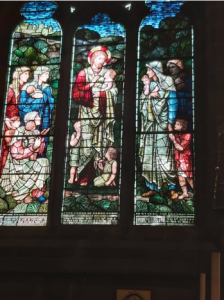
In the third of the Swinton Library Community and Local History talks, attendees were taken back to the late 1800s to the time of Noah Robinson, the man who is widely believed to be Swinton’s Founding Father.

By the 1860s, the population had doubled and Swinton Parish Church, St Peter’s, was started to be built, being completed by late 1869, with the church containing a lychgate, the area of the church where coffins are carried in and out.
It is in this lychgate where Robinson is introduced, immortalised as the depiction of St Peter in the decorative elements.
Born on Chapel Street in Salford in 1826, Robinson moved to Swinton early in life, where he would spend the rest of his days. He kept himself busy during his life, having no fewer than three roles at any one time, including the Churchwarden at St Peter’s, Treasurer of the local school and a member of the Board of Guardians, the latter role he held until just seven years before his death.
His father owned the Albert Mill in Swinton, which was the only mill in the area to continue production during the Cotton Famine caused by the American Civil War.
Having seen the workers of the other local mills being forced into poverty, he knew he had to try and do something to improve the way of life for those unemployed.
Robinson was elected to the Board of Guardians unknowingly but he went about improving the village with his fellow Guardians, opening a new union office in Patricroft.
As a Guardian, Robinson noticed that those in the work house were often uneducated, leading to Robinson pushing to improve education to reduce poverty, spearheading the building of a new school, St Peter’s Day and Sunday School, where he would be Treasurer from 1864 to 1898.
Just a few years later there would be a cholera outbreak in Swinton around the two wells in the village. In those days, public health was dealt with as a “nuisance” meaning it had to go through a very inefficient system to be dealt with, until a change in the law allowed for local committees to be formed to deal with these “nuisances”.
A meeting with the Guardians after the outbreak led to Robinson appointing one of these committees, which met daily, and the formation of a local government board coming later, following a unanimous decision in a meeting at the local pub.
This local government would hold its first meeting in 1868, turning into the Swinton and Pendlebury Board in 1869, with a clean water supply coming in during 1870. A gas supply, street lamps and pavements would also come to Swinton courtesy of this board.
Robinson would retire from his Guardian position in 1900, having already giving up his roles as Treasurer at the school and Churchwarden at St Peter’s. He would be honoured in 1901 with a memorial garden, which was publicly funded showing his popularity within the community, with St Peter’s Church also installing a memorial window to the church in 1909, two years following his death.
















Recent Comments